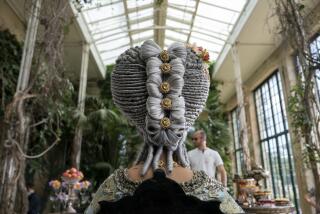‘Do It Da Vinci Style
- Share via
Never have another bad hair day. A new styling system, based on measurements discovered in the 15th Century by Leonardo da Vinci, makes this promise. The system, which uses a grid to measure head length and width, can help both sexes choose hairstyles that will create a visually balanced face and head, says Marilyn Curtin of Viva Da Vinci Hairstyle Design in Irvine.
Artist’s Way Da Vinci realized that, by measuring sections of the head and placing the center of the head at the bridge of the nose, he could pinpoint features that seemed out of balance. 1. Top of head to hairline. 2. Hairline to bridge of nose. 3. Bridge to base of nose. 4. Base of nose to chin.
Styling Rules Use hair to compensate for shorter measurements. Avoid a definitive part, unless skin tone is even. The more even the skin tone, the more dramatic the hairdo.
Beauty Grid The Da Vinci System adapted the idea of measuring head width and length for balance. Side View: 1. Center of grid is placed just in front of the ear; measurements compare distances from center to various points on head. 2. If distance from top of head to the center is shorter than distance from center to base of neck, add height to your hairstyle. 3. If distance from bridge of nose to the center is longer than distance from center to back of head, add volume to back of head. 4. If distance from nape of neck to center is shorter than center to forehead, add fullness at nape. Front View: 1. Width from outer ear to outer ear. 2. Length from chin to crown.
Your Better Side Your photogenic side is your dominant side. Hair will style easier and look more flattering if directed this way. Dominant side traits: Usually higher hairline. More hair growth. Hair on forehead grows upward with a slight lift. Face and head larger than narrower side.
Men’s Issues Decisions on hair length, sideburns and mustaches should be based on head length. An elongated head should have a short beard; a short head needs a longer beard. Those with thin necks should add volume to beard or wear their hair longer.
Looking Good Looking your best means working with your natural features and measurements. Some tips to make the most of what you have: Height: Crown appears flat: Add height. Crown appears pointed: Wear flat on crown and end style at shoulders. Chin is pointed: End hairstyle at shoulders. Volume: Round or moon-shaped head/face: Wear hair close to head. Neck is thin: Fill area with volume. Cowlick present: Add volume to crown. Nape of neck is flat: Don’t add volume to back of head. Length: Neck too thick: Keep style short and close to neck. Back of neck is angled: Fill out area with shoulder-length cut. Neck too thin: Add length to hairstyle. Bangs and Sideburns: Front hairline grows close to eye area: Comb hair away from face; do not wear sideburns. High forehead: Style hair toward eyes using wispy bangs; wear sideburns. Forehead angled: Wear a straight bang. Ears: Ears and eyes level: Expose top of ear. Eyes slightly higher than ears: Cover top of ears. Ears slightly higher than eyes: Style hair to fall under lobe. Ears protrude: Cover with hair.
* Source: Viva Da Vinci Hairstyle Design, Encyclopedia Brittanica; Researched by APRIL JACKSON/Los Angeles Times






